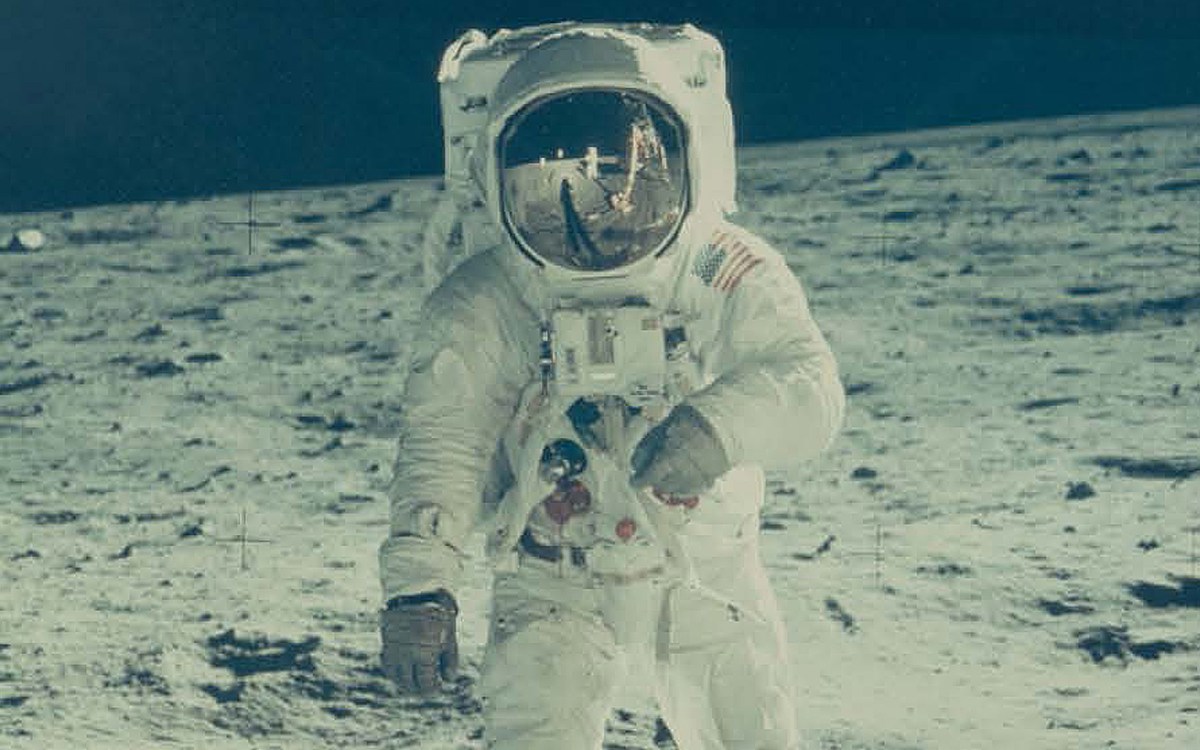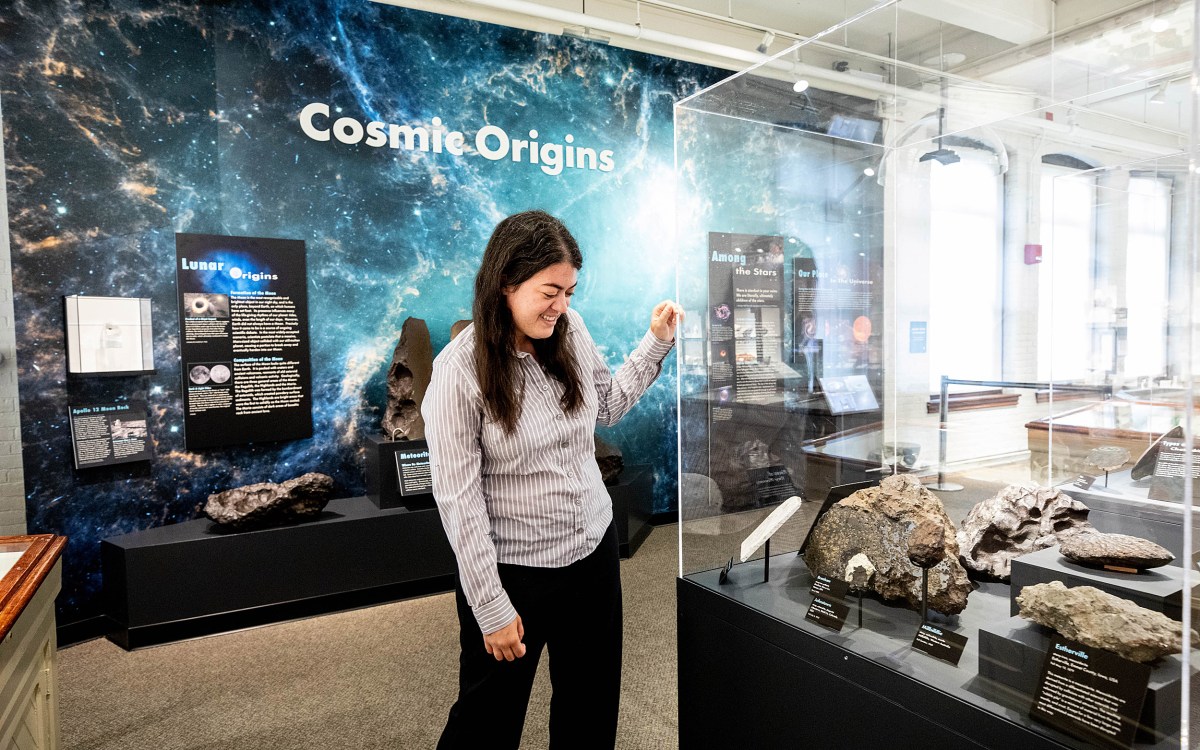Video by Justin Saglio/Harvard Staff
Harvard reflects on Apollo 11 and Neil Armstrong’s moon walk
Trio of astronomers discuss a giant leap for a man, 50 years later
Six-year-old Alyssa Goodman found watching astronauts walk on the moon on TV astonishing. To 8-year-old Dimitar Sasselov, his parents’ excitement over the 30-second clip of Neil Armstrong’s walk belied the downplay it received in Soviet-era Bulgaria. And to Irwin Shapiro, then an MIT physics professor, the technical achievement of getting Armstrong there outshone the walk itself.
Three Harvard astronomers shared recollections of humankind’s first walk on the moon 50 years ago Saturday, as well as their thoughts on its wide-ranging legacy.
Life’s highest achievement
Sasselov, Phillips Professor of Astronomy and head of Harvard’s Origins of Life Initiative, was a young boy growing up on Bulgaria’s Black Sea coast in 1969. He was more interested in the beach than in space then. But his parents made sure he knew about, and watched, the landing — even though the government minimized the Cold War achievement.
Now Sasselov’s view is likely best described as cosmic. Life in the universe is probably uncommon, he says, and where it exists it is largely made up of microbes, as it was for most of its history on Earth. For those microbes to have given rise to complex life, and for that complex life — along with microbial hitchhikers — to intentionally travel to another celestial body, and back, has to be considered a milestone not just for one species but for all of life.
“Here you have, 4 billion years after the creation of the Earth biosphere, a representative … [who] by their own volition and their own design made it beyond the planet, which is the root of the biosphere, to go to another celestial body, stay there, and then return safely back to where they came from,” Sasselov said. “That for sure has never happened before in the history of the solar system.”
What is possible to achieve
Goodman, the Robert Wheeler Wilson Professor of Applied Astronomy and co-director for science at the Radcliffe Institute for Advanced Study, recalls sitting on her parents’ bed in their home on Long Island and being amazed that Armstrong was walking on “that thing in the sky” at that very moment.
To her, the moon landings are an example of what it is possible for humans to achieve when vision, political will, financial wherewithal, and technical prowess all pull toward a single goal. Goodman acknowledged that such unified purpose is rare and has been missing in the decades since. Other examples, real and potential, are the Manhattan Project, which led to the first atomic bomb, and, she hopes, a project to find a solution to climate change in the years to come.
Interactive imagery at WorldWide Telescope gives users an astronaut’s view of the moon by allowing them to zoom and pan around the Apollo landing sites.
To Goodman, who specializes in data visualization and is a leader of the WorldWide Telescope project, Apollo 11’s most amazing technical achievement may have been figuring out how to beam television images from the moon. Granted, they weren’t great images, she said, but when she thinks about people complaining about video speed and other bandwidth issues today and reflects on the live images from the moon in 1969, she is amazed all over again.
“When I think about it today — a moment when science made a gigantic impact on my life — it clearly was that moment. I was a child of that,” Goodman said. “I look at my own daughter, who’s almost 22 years old, [and] at what happened when she was a little kid: 9/11. That’s not the kind of positive, incredibly emotional memory that you want somebody to have. So I feel very, very lucky that that’s what I had when I was a little kid.”
Blasé, with tears
Shapiro, Harvard’s Timken University Professor and former director of the Harvard-Smithsonian Center for Astrophysics, was well into his scientific career when Armstrong stepped from the landing pad of the lunar lander Eagle onto the dust of the Sea of Tranquility.
A physics professor at MIT in 1969, Shapiro recalls watching the grainy, black-and-white image of that “giant leap” at home with his children, but said somehow he couldn’t match their enthusiasm.
“Maybe I was too blasé already by that time in my life,” Shapiro said. “I had been following along from [President John] Kennedy’s announcement in ’61.”
However, he admired the method chosen for the mission. Several had been considered, including launching a single rocket that would travel to the moon, land, and return, but the technical hurdles were very, very high. Instead NASA opted to launch a rocket into lunar orbit, then use a lander to ferry astronauts to the moon’s surface and back to the command module for the return to Earth.
“I thought that was a very clever decision,” Shapiro said. “I was very impressed.”
Though his enthusiasm initially was muted, Shapiro nonetheless appreciates the magnitude of the nation’s success with pride, and keeps a copy of Life Magazine from the time on the mantelpiece at home.
“Even now I tear up. It was quite an achievement,” Shapiro said. “I mean really. This is something that will not be forgotten in all of human history: the first landing on the moon.”








